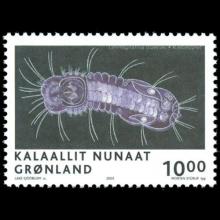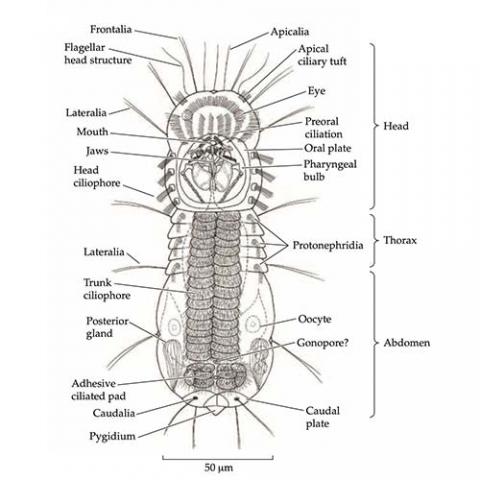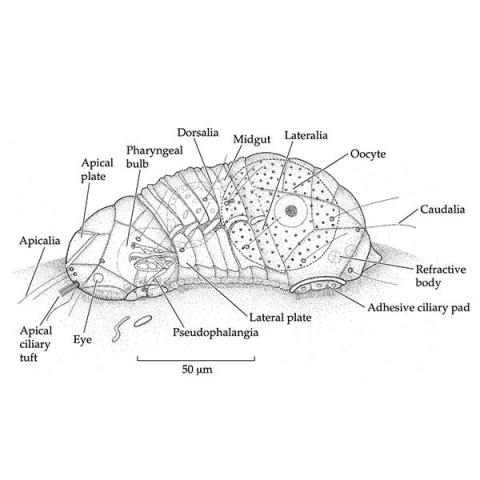NAMES
TAXONOMY
Greenland
Issued:
Stamp:
Limnognathia maerski
Greenland
Issued:
Stamp:
Limnognathia maerski
Greenland
Issued:
Stamp:
Limnognathia maerski
The Gnathifera - Phyla Gnathostomulida, Rotifera (including Acanthocephala), and Micrognathooa
(excerpted from)
Until the mid-1990s, the Gnathostomulida and Rotifera were pooled together with other microscopic taxa in questionable groupings such as "Aschelminthes" or "Nemathelminthes" -catchall grouping that were more or less solely characterized by hosting microscopic taxa with uncertain phylogenetic positions. At that time, the Acanthocephala was treated as a distinct phylum, but despite their macroscopic size and endoparasitic biology, they were already considered to be closely related to the Rotifera, based on ultrastructural similarities in their integuments.
. . .
At the same time Grathifera was taking its shape, another new animal was discovered in mosses from a cold spring in Greenland. It was a tiny microscopic invertebrate that in some respects resembled a rotifer, and in other ways a gnathostomulid, but also possessed several characteristics that were not found in any other groups. The animal had jaws that were even more complex and numerous in elements than those found in the other two gnathiferan phyla. Transmission electron microscopy showed that the ultrastructure of the jaws was nearly identical with that of the Rotifera and Gnathostomulida. Six years after the dicovery, R. M. Kristensen and P. Funch (2000) named the animal Limnognathia maerski, and assigned it to a new animal group Micrognathozoa, which four years later was recognized as a third gnathiferan phylum.
Reference: rickbrusca.com
Genus species (Animalia): Limnognathia maerski
Limnognathia maerski is a microscopic platyzoan freshwater animal, discovered living in warm springs on Disko Island, Greenland in 1994, that has variously been assigned as a class or subphylum in the clade Gnathifera or as a phylum in a Gnathifera superphylum, named Micrognathozoa. It is related to the rotifers and gnathostomulids, grouped together as the Gnathifera. With an average length of one-tenth of a millimeter, it is one of the smallest animals known.
L. maerski has very complicated jaws, with fifteen separate elements. The parts of the jaw structure are connected by ligaments and muscles. The jaw parts are very small, ranging from 4 μm to 14 μm. The animal can extend part of its jaw structure outside its mouth while eating. It also extends much of its jaw structure outside its mouth when it is regurgitating items that are indigestible. Its main diet is bacteria, blue-green algae and diatoms.
L. maerski has a large ganglion, or 'brain', in its head, and paired nerve cords extending ventrally (along the lower side of the body) towards the tail. Stiff sensory bristles made up of one to three cilia are scattered about the body. These bristles are similar to ones found on gnathostomulids, but up to three cilia may arise from a single cell in L. maerski, while gnathostomulids never have more than one cilium per cell.
Flexible cilia are arranged in a horseshoe-shaped area on the forehead, and in spots on the sides of the head and in two rows on the underside of the body. The cilia on the forehead create a current that moves food particles towards the mouth. The other cilia move the animal.
All specimens of L. maerski that have been collected have had female organs. They lay two kinds of eggs: thin-walled eggs that hatch quickly, and thick-walled eggs that are believed to be resistant to freezing, and thus capable of over-wintering and hatching in the spring. The same pattern is known from rotifers, where thick-walled eggs only form after fertilization by males. The youngest L. maerski specimens collected may also have male organs, and it is now theorized that the animals hatch as males and then become females (sequential hermaphroditism).
The Gnathifera is the sister group of the spiralians and is crucial to understand because of its relationship to animal evolution.
Reference: Wikipedia
Note: Although their is new evidence that this species may the taxonomy and classification is still getting sorted out (as shown in the Wikipedia page and the excerpt from rickbrusca.com), applying the Seven Kingdom model places them in the phylum Rotifera on this website.





